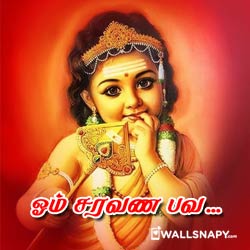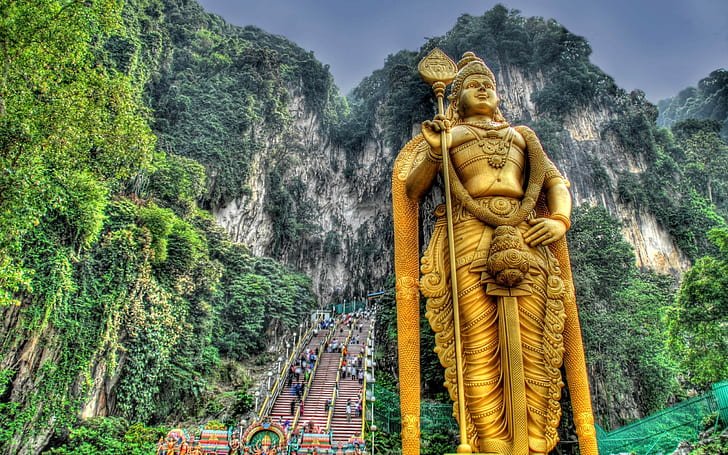
(c) Murukan is also found standing in vaiśākha posture with two hands. Valli and Deivānai are found on either side of Murukan. (b) Murukan is also found with six faces and six pairs of hands. (a) Murukan is found standing is vaiśākha- sthānaka with four hands. The Jambukeswarar Temple in Tiruvānaikoyil (Thiruvanaikaval). (b) There is also the sannidhi for Murukan with his consorts Valli and Deivānai to the right of the entrance. The Arunachaleswara Temple (Aruṇācaleśvar) in Thiruvannamalai (Tiruvaṇṇāmalai), : (a) Murukan is represented as seated in sukhāsana on his peacock.

Murukan (Murugan) is the name of a deity depicted in various temples: Source: Shodhganga: The significance of the mūla-beras (śilpa) Lord Murugan was born from the Tejas or intense energy of Lord Śiva in order to relieve the gods of the oppression of Tārakāsura who had gained a boon of invincibility from Brahmā. When all the five senses and the mind as the co-ordinating factor are sublimated and directed towards enlightenment then one attains super-consciousness. The several and collective human perfections are all personified in Murugan. Skilful action ( kuśala karma) is that which is direct at Ātmā bodha -self-realization. Murugan in Shilpashastra glossary Source: Red Zambala: Hindu Icons and Symbols | Inner Circle IVĪs the second son of Lord Śiva, Murugan the embodiment of skilful action, just as Gaṇeśa is the personification of wisdom. Closely related to Shaktism, Shaiva literature includes a range of scriptures, including Tantras, while the root of this tradition may be traced back to the ancient Vedas. Shaiva (शैव, śaiva) or Shaivism (śaivism) represents a tradition of Hinduism worshiping Shiva as the supreme being.

Tiruchendur (Devasenāpati aspect and rendition of Sūrapadma),.Svamimalai (Murukan teaching the meaning of praṇava to Śiva).Palani (Murukan obtaining the fruit of wisdom and appearing as ānṭi, a person owing nothing of his own).Destroys the enemies in fierce battles,.Discovers the hidden truths and enlightens minds of sages,.Casts a gracious look and grants boons,.Diffuses radiance and dispels darkness,.‘Peacock’ stands for the killer of time and thereby birth and death.Įach of the six faces of Murugan (Murukan) brings out various philosophical meanings namely, ‘Serpent’ stands for the cycle of years or the cycle of births. He rides on the peacock, the killer of serpents. Murugan is praised as a great Siddha of Bāla-varga group. He is also called Skanda, Murukan, Kandasāmi, Supraya Kumāra, Saravana, Kārtikeya, Kāṅgeyan, Āṟumukha, Ṣanmukhan, Velāyuda, Sūra Samhāra Mūrti, Mailerivelan and Tārakājit. Murugan (or Murukan) is also called Subrahmaṇya. Source: DSpace at Pondicherry: Siddha Cult in Tamilnadu (shaivism)

The iconography of Subrahmanya is elaborated at length in the Kumaratantra and Śrītattvanidhi. The cult of Muruga was a well developed one ever since the Cankam period in Tamilaham. Muruga, the second son of Siva and Parvati, is variously known as Subrahmanya, Shanmukha, Karttikeya, Skanda, Devasenapati, Śikhivahana Saravanabhava, etc. There are numerous temples dedicated to Lord Murugan in India, Sri Lanka, Malaysia, Singapore, United Kingdom, New Zealand, and Canada.Murugan in Shaivism glossary Source: Murugan: The Iconography of Murugan He was also called Karthikeyan as there where six ladies called Karthigai to look after Him. When Goddess Parvati hugged them together, they joined to become one form with six faces, twelve hands and were named Skandan. Later Ganga took them to the Saravan pond where the six sparks became six babies on six red lotus flowers. Lord Shiva asked Lord Vayu and Lord Agni to take the fire sparks to River Ganga. Shiva took a form with six faces and from the third eye of each face a spark came out.

The cruelty of Soorapadman, the demon was getting intolerable to all the deities and they ran to Lord Shiva for help. After the marriage of Lord Shiva and Goddess Shakti, it is said that knowledge and grace joined together to give a Bliss, that is Lord Muruga.


 0 kommentar(er)
0 kommentar(er)
